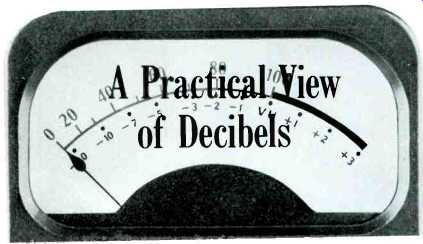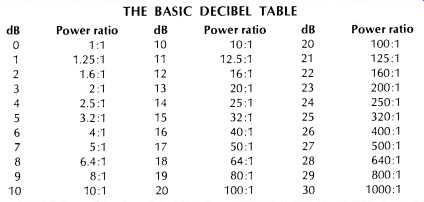
by GEORGE H. R. O'DONNELL
TODAY THE LACK of understanding, plus careless use of the decibel is leading to needless confusion.
Yet by a practical method shown here, proper use of these terms--dB, dBm, and VU--is easily attainable, and I believe one could obtain accurate results comparable to those laboriously obtained by customary use of the standard formulas such as:
dB =10 log10 P2/P1
dB20 log10 E2/E1
dB = 20 log10 I2/I1
P=2^dB/3
Explanations & Observations
a) Decibel Number (DN): In 12 dB, it's the '12'; in 23 dB, it's the '23'.
b) Decibel Equation (DE): Such equations look like this: 12 dB= 16:1 12 dB= 4:1
This, a power equation, gives the power ratio.
This is the voltage or current ratio.
c) Unit, Figure, Number:
A unit is a natural whole: acorn, oak, forest; egg, chicken, flock; man, clan, tribe, population. They are standard statistical entities! Like eggs in a supermarket, they come small, medium, and large. There's little 'standard' about them. And it is precisely for that reason that units must be sharply defined when accuracy, precision, and maximal clarity are desired.
That's why 'decibels' must be defined.
A figure, as used in this article and in immediate close association with the word `number', is any one of the 10 characters, or signs, of quantity: 0, 1, 2, 3, 4, 5, 6, 7, 8, and 9.
A number is a quantity, standing alone, and made up of one or more figures. '777' is one number, but three figures. Though identical, the 7's are all different through position: the first means `700', the second '70', and the third just '7' .. However, note that when used alone, we may pick individual figures out of any number: in 20 dB= 100:1, the '2' and the two 0's are directly related, as we shall see. In 120 dB=1,000,000,000,000:1. This is the same relationship, but we'll take care to refer to the '12' as the first part of the decibel number. Both of these first equations provide, by mere inspection, the number of digits in their power ratios, and vice versa, so if you have the power ratio, you know its decibel number at once.
d) Ratio: In decibels, there are only two: power ratios, and voltage or current ratios. The second is always the square root of the first, or the first is the square of the second. The quantities may be any. Usually the last named ratio quantity is a '1' (obtainable by dividing both quantities by the smaller). Remember that the ratio '1:1' means only that the two quantities are identical; it does not mean that they are just `1's'; they can be ‘23:23’, ‘47:47’, or any other pair of identical numbers. This brings us squarely to the meaning of '0 dB', which means that there is no difference between the two quantities being described.
e) Decibel Table (DT): All power ratios that contain the same number of figures (no matter what the figures are) belong in the same decibel table.
There are ten DE's in each table, but we give eleven, using the last of any one table as the first of the next. The decibel number of one equation in a table differs from that in the adjacent equation above or below by just 1 decibel. The first decibel number in any table is always 10 dB less than the first of an adjacent table. There is no need to learn table numbers, but if you want them too, they are always equal to the number of figures making up the power ratio. You choose the right decibel table at all times by inspection.
Given any decibel number--what is its power ratio?
Rule 1: First, divide the decibel number by 3. Since 3 dB represents twice the power ratio, the resulting quotient indicates the number of times the power must be doubled (or halved) to reach the specified decibel number. For example, what is the power ratio corresponding to 9 dB? Dividing 9 by 3 gives a quotient of 3.
Thus the power must be doubled (or halved) three times, or 2x2x2, or 8 times. Therefore, 9 dB represents a power ratio of 8:1.
Rule 2: If the given decibel number is not exactly divisible by 3, add to it, or subtract from it, 1 dB. The power ratio now resulting will be either too high (if you added 1 dB) or too low (if you subtracted 1 dB) . If it is too high, decrease the power ratio by one fifth; if too low, increase it by one-fourth. For example, what is the power ratio corresponding to 13 dB. From Rule 1, we can learn that 12 dB= 16:1 (12/3=4; 2x2x2x2=16). The '16' is obviously too small; increased by one fourth it becomes 16+ 4=20; so 13 dB=20:1.
Now we apply this Rule to derive the first and basic decibel table, by getting at it backwards. If 9 dB = 8:1, 10 dB will be one-fourth more, or 10:1. We already have 9 dB equaling 8:1, and 8 dB-one less than 9-requires taking one-fifth less than 8:1.
Thus, one-fifth of 8= 1.6, and 8-1.6 =6.4, so 8 dB represents a power ratio of 6.4:1.
Rule 3: Adding 3 dB to any decibel equation doubles the power ratio; subtracting 3 dB halves the power ratio.
Thus, if 10 dB represents a power ratio of 10:1 (Rule 2) then 10-3 or 7 dB represents a power ratio of 5:1.
Similarly, if 6 dB=4:1, 3 dB=2:1.
If 3 dB=2:1, then 0 dB=1:1.
From this we see that there is a difference of 0 dB between two signals, they are of exactly the same level, and that's what dB are all about. They always represent a ratio, and as such are a logarithmic quantity. And logarithms scare most people.
We now present the first and basic decibel table (the left column) . And alongside it are the next two decibel tables, showing how the values progress, each by a factor of 10.
Note: The second equation power ratio (1.25:1) gives the ratio 5/4:1, and is the basis for another rule.) For example, 5/4x5/4x5/4 =125/64 =2:1.
Thus the '5' and the '4' are special.
Whenever you come across either of these figures, you are to double the '6-4' to a 1-2-5, and halve any 1-2-5 into a 6-4. That is the price our method pays for using 1.25:1 instead of 1.2589:1 (for 1 dB). Rule 4: To add any two decibel equations, add only their decibel numbers, but multiply their power ratios (never their voltage or current ratios) . To subtract any two decibel equations, subtract only their decibel numbers, but divide their corresponding power ratios. For example:
12 dB=16:1 ---- 12 dB=16:1
+3 dB= 2:19 ---- dB= 8:1
15 dB=32:1 ---- 3 db= 2:1
These examples, and those given previously, are obviously only one method by which, using the basic table, any higher or lower equation can be built up. For instance, given the power ratio 256:1; what is its decimal number? From the basic table, the nearest multiple to 256 is 2.5:1 (4 dB) . The three figures in the '256' indicate that your multiplier must be '100' (20 dB) . Then you have two equations to add:
20 dB=100:1
4 dB= 2.5:1
_________
24 dB=250:1
(which is close enough since the correct number of dB is 24.082.)
THE BASIC DECIBEL TABLE

Voltage & current ratios
Now that you can solve the power ratio easily, you will want to know how to determine voltage or current ratios, so we come to Rule 5: Having any power ratio, take its square root to have the corresponding voltage or current ratio. For example:

The dBm
Since the dB is now established as a ratio, and only as a ratio, if a given level is to be indicated by a decibel number, it must be referenced to some standard level. And since the usual reference level used professionally in transmission of audio signals is referred to as 1 milliwatt across 600 ohms,' the chosen reference becomes that same '1 milliwatt', and the term dBm is created, with the 'm' standing for the milliwatt. Thus a reference to a level of +8 dBm now means something. The actual level indicated by +8 dBm means that it is 8 dB above 1 milliwatt across 600 ohms. It's as simple as that. While heretofore we had a ratio, we now have a ratio referred to a specified quantity, and we are no longer saying that something is three times as long, for example, but instead we are saying that a level is three times as great as a fixed level, which corresponds to an increase of about 5 dB.
The Volume Unit (VU)
The VU is based on the same scale of values, but when a program is specified as having a level of +4VU, it means two distinct things: (1) it is referenced to a level of 1 milliwatt in 600 ohms, and (2) it is measured on program material (not sine waves) with a meter having specified characteristics. Among these characteristics are its resistance (3900 ohms), its ballistic characteristics (the pointer must reach 99 percent of its final deflection to an applied signal in 0.3 seconds, and its over-swing shall be between 1.0 and 1.5 percent when the tone is applied) .
The standard VU meter has a yellow dial and is normally illuminated for use in recording and broadcast studios. Its rectifier characteristics are also specified. Thus it will be noted that not all meters that are labeled "VU" are actually VU meters, even though they may have yellow dials. They do, however, serve to give the user a reference indication of the signal level in a manner that is useful in recording and broadcast applications. After some use of a specific instrument, the operator will become sufficiently familiar with its characteristics so that his recordings or his station output are consistent from program to program.
For a more thorough treatise on the VU meter and its applications, the reader is referred to "The Measurement of Audio Volume," by Howard Chinn, which appeared in the September and October, 1951, issues of Audio, and to "Volume Measurements of Electrical Speech and Program Waves", American Standards Association, C-16.5 (1942).
(Audio magazine, Feb. 1970)
Also see:
The Measurement of Loudness (Feb. 1972)
Buying Watts and Other Things (Feb. 1973)
= = = =